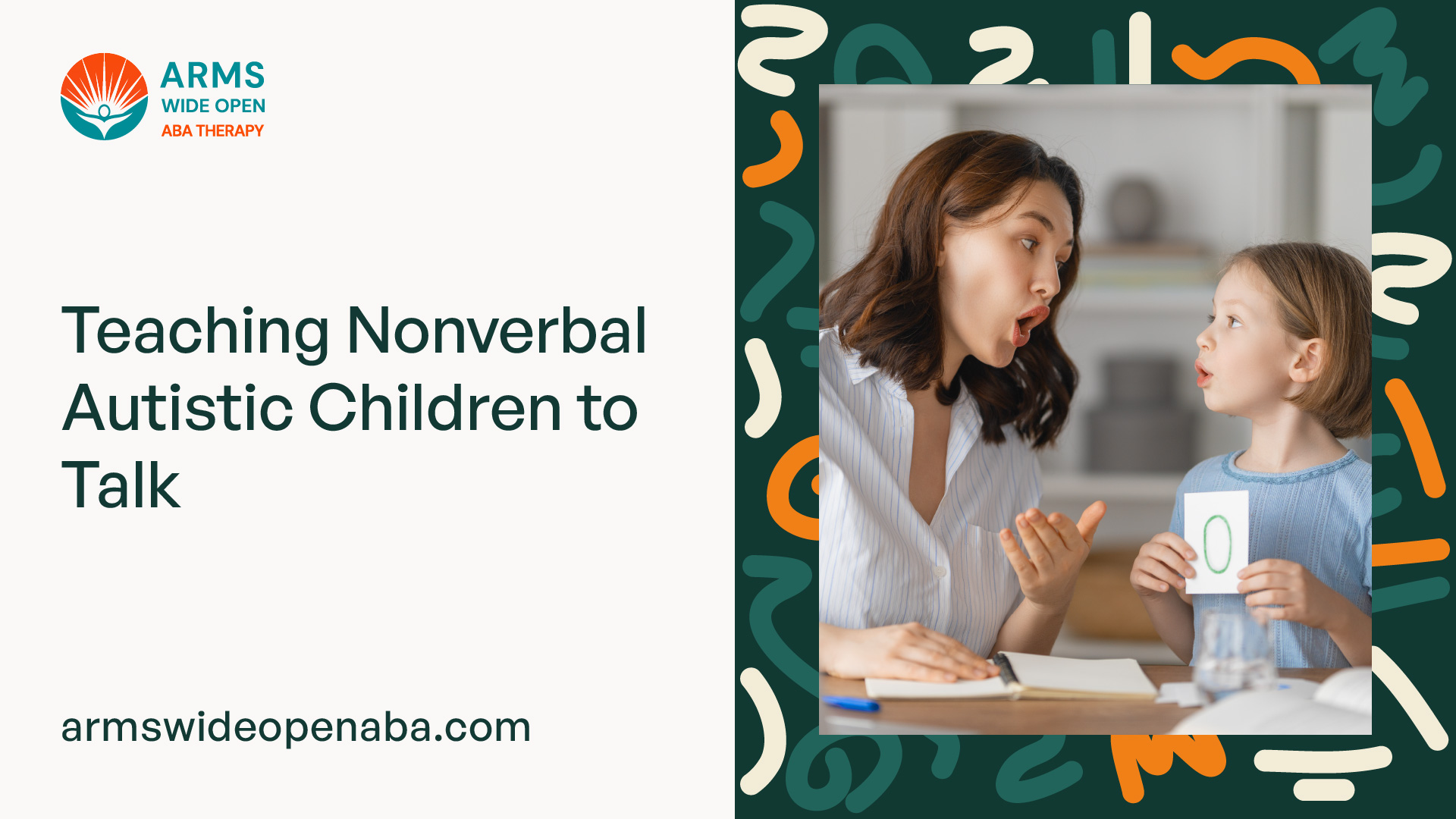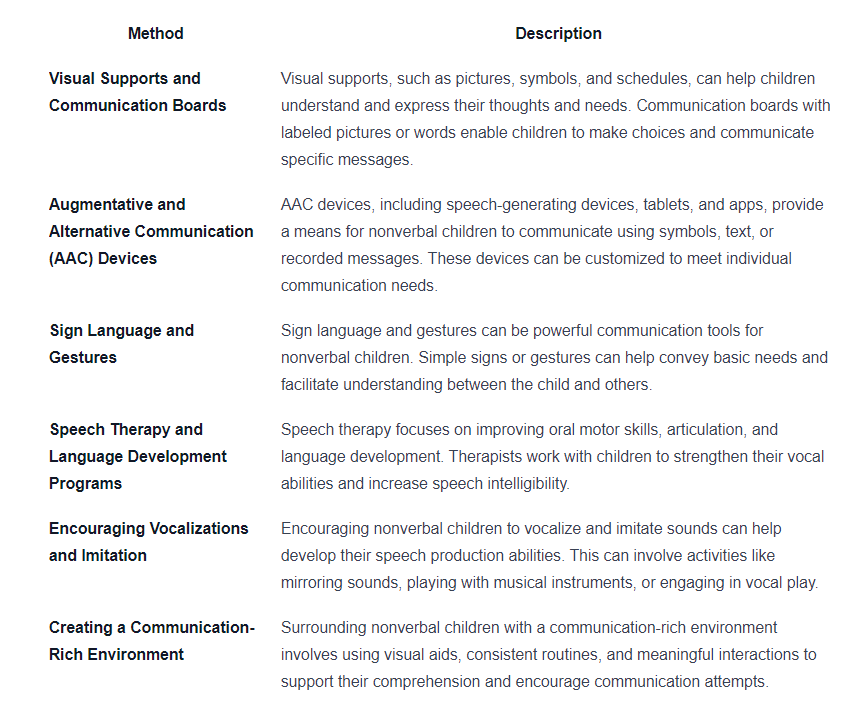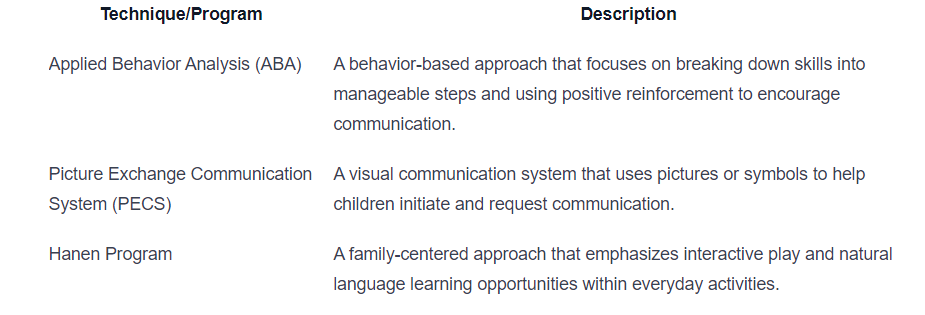Teaching Nonverbal Autistic Children to Talk
Unlock the power of communication for nonverbal autistic children! Discover effective strategies to teach them to talk and thrive.

Understanding Nonverbal Autism
For individuals with autism spectrum disorder (ASD), communication difficulties can manifest in various ways. Nonverbal autism refers to a subset of ASD where individuals have significant challenges in spoken language. Understanding the characteristics and challenges associated with nonverbal autism is crucial for implementing effective strategies to support these individuals.

Characteristics of Nonverbal Autism
Nonverbal autistic individuals have limited or no functional verbal language. They may struggle with speech sounds, vocabulary, grammar, and/or the ability to use language in a meaningful and reciprocal manner. However, it's important to note that nonverbal autism is a spectrum, and the severity of communication difficulties can vary among individuals.
Characteristics
Limited or no functional verbal language
Difficulty with speech sounds, vocabulary, and grammar
Challenges in using language in a meaningful and reciprocal manner
Varying severity of communication difficulties
Challenges Faced by Nonverbal Autistic Children
Nonverbal autistic children encounter numerous challenges related to communication. These challenges can significantly impact their ability to interact, socialize, and participate in daily activities. Some common challenges faced by nonverbal autistic children include:
Challenges
Difficulty expressing needs, wants, and emotions
Limited ability to engage in social interactions and conversations
Frustration and heightened anxiety due to communication barriers
Potential isolation and difficulty forming friendships
Difficulty accessing educational opportunities and learning experiences
Understanding these challenges is essential for developing effective strategies to teach nonverbal autistic children to communicate. By addressing these challenges through targeted interventions and support, it is possible to unlock the voice of nonverbal autistic children and help them communicate more effectively with the world around them.
Importance of Communication
Communication plays a vital role in the development and well-being of nonverbal autistic children. It serves as a gateway to understanding and connecting with the world around them. In this section, we will explore the benefits of developing communication skills and the different methods available for nonverbal autistic children to express themselves.
Benefits of Developing Communication Skills
Developing communication skills in nonverbal autistic children can have a profound impact on their overall development and quality of life. Here are some key benefits:
- Enhanced Social Interaction: Communication skills allow children to engage and interact with others, fostering meaningful relationships, and reducing social isolation.
- Improved Emotional Expression: By learning to communicate, children can more effectively express their emotions, needs, and desires, reducing frustration and promoting emotional well-being.
- Increased Independence: The ability to communicate empowers children to make choices, advocate for themselves, and participate more actively in daily activities.
- Academic and Learning Opportunities: Communication skills are crucial for academic success, as they enable children to understand instructions, participate in classroom discussions, and access educational resources.
Different Methods of Communication
Nonverbal autistic children may use various methods to communicate effectively. It's important to explore and identify the most suitable approach for each child. Here are some common methods:

By recognizing the importance of communication and exploring different methods, educators, therapists, and caregivers can effectively support nonverbal autistic children in their journey to develop communication skills. It's crucial to tailor approaches to each child's unique needs and provide ongoing support to foster their progress.
Strategies for Teaching Nonverbal Autistic Children to Talk
When it comes to teaching nonverbal autistic children to talk, there are several effective strategies that can be implemented. These strategies focus on providing alternative forms of communication and gradually building verbal skills. Here are three key approaches that can be used:
Visual Supports and Communication Boards
Visual supports and communication boards are valuable tools for facilitating communication in nonverbal autistic children. These supports use pictures, symbols, or words to represent objects, actions, and emotions. By using visual cues, children can understand and express their needs, wants, and thoughts more effectively.
These supports can be created in various formats, such as PECS (Picture Exchange Communication System), where children learn to exchange pictures to communicate their desires. Visual schedules and social stories are other examples that help children understand routines and social situations.

Augmentative and Alternative Communication (AAC) Devices
Augmentative and Alternative Communication (AAC) devices are electronic or non-electronic tools that aid communication for nonverbal autistic children. These devices range from simple picture-based communication apps on tablets to more advanced speech-generating devices. AAC devices can be customized to meet the individual needs of each child.
AAC devices provide a means of expressing thoughts, needs, and emotions through symbols, text, or synthesized speech. These devices can significantly enhance communication and improve social interactions for nonverbal autistic children.

Sign Language and Gestures
Sign language and gestures offer an effective method of communication for nonverbal autistic children. American Sign Language (ASL) or modified sign systems can be taught to children to enable them to express themselves and understand others.
Gestures, such as pointing, nodding, or shaking the head, can also be used to enhance communication. These non-verbal cues can help children convey their needs and preferences, even before they develop verbal skills.

By utilizing visual supports, AAC devices, and sign language/gestures, educators and caregivers can create a communication-friendly environment for nonverbal autistic children. These strategies provide alternative means of expression and lay the foundation for further development of verbal skills. It's important to tailor these approaches to the individual needs and preferences of each child, ensuring effective and meaningful communication interactions.
Building Verbal Skills
When it comes to teaching nonverbal autistic children to talk, there are various strategies that can be employed to help them develop verbal skills. These strategies aim to foster communication and encourage the expression of thoughts and needs. In this section, we will explore three effective approaches: speech therapy and language development programs, encouraging vocalizations and imitation, and creating a communication-rich environment.
Speech Therapy and Language Development Programs
Speech therapy and language development programs play a vital role in supporting nonverbal autistic children in their journey towards verbal communication. These programs are designed and facilitated by speech-language pathologists (SLPs) who specialize in working with individuals with communication disorders, including autism.
Through structured and individualized therapy sessions, SLPs focus on various aspects of language development, such as vocabulary, grammar, and articulation. They employ techniques and exercises tailored to each child's specific needs, helping them build a foundation for verbal communication.
Benefits of Speech Therapy and Language Development Programs
- Enhances speech and language skills
- Improves articulation and pronunciation
- Enhances vocabulary and grammar
- Builds conversational and social communication skills
- Promotes confidence in communication
Encouraging Vocalizations and Imitation
Encouraging vocalizations and imitation is another effective strategy for teaching nonverbal autistic children to talk. This approach focuses on creating a supportive environment that motivates the child to vocalize sounds and imitate words and phrases.
By modeling vocalizations and engaging in playful activities, caregivers and educators can stimulate the child's interest in verbal communication. They can use simple and repetitive sounds, words, and gestures to encourage the child to imitate and respond. Positive reinforcement, such as praise and rewards, can also be used to reinforce and motivate the child's attempts at verbal communication.
Creating a Communication-Rich Environment
Creating a communication-rich environment is crucial for facilitating the development of verbal skills in nonverbal autistic children. This involves incorporating various strategies and supports that encourage and support communication throughout the child's daily routines and activities.
Some effective ways to create a communication-rich environment include:
- Using visual aids, such as picture schedules and visual supports, to help the child understand and anticipate daily activities.
- Implementing structured and predictable routines to provide a sense of security and enable the child to communicate their needs and preferences.
- Incorporating communication boards or AAC (augmentative and alternative communication) devices that offer visual representations of words and phrases, allowing the child to communicate effectively.
- Providing opportunities for social interaction and turn-taking, such as engaging in conversation and playing games that require verbal communication.
By creating an environment that promotes communication and supports the child's efforts, nonverbal autistic children can develop their verbal skills and gain confidence in their ability to express themselves.
Remember, each child is unique, and progress may vary. It's important to celebrate every small milestone and provide consistent support and encouragement throughout the child's communication journey. Collaborating with professionals, such as speech therapists and special educators, can further enhance the effectiveness of these strategies in teaching nonverbal autistic children to talk.
Patience and Persistence
When teaching nonverbal autistic children to talk, it is crucial to approach the process with patience and persistence. Every child is unique, and progress may vary. Here are some strategies to keep in mind throughout the journey:
Understanding Individual Needs and Progress
Understanding and addressing the individual needs of nonverbal autistic children is essential. Each child may have different communication challenges and strengths. It is important to observe and assess their progress regularly to tailor the teaching strategies accordingly.
By recognizing individual needs, educators and caregivers can develop personalized communication plans that focus on the specific areas where the child requires support. This approach ensures that the child receives the targeted assistance they need to make progress in their communication skills.
Celebrating Small Milestones
In the process of teaching nonverbal autistic children to talk, it is important to celebrate even the smallest milestones. Each step forward, no matter how small, is significant and should be acknowledged and celebrated.
By recognizing and celebrating these achievements, you can boost the child's confidence and motivation to continue working on their communication skills. This positive reinforcement encourages them to persist in their efforts and reinforces the value of communication.
Consistency in Communication Strategies
Consistency is key when teaching nonverbal autistic children to talk. Using consistent communication strategies and techniques helps create a familiar and predictable environment for the child, which can support their learning and understanding.
Consistency extends to both verbal and nonverbal communication. It's important to be consistent in using visual supports, AAC devices, sign language, or any other communication method employed. This consistency helps the child develop a sense of predictability and allows them to build connections between different communication cues.
By maintaining consistency in communication strategies, educators and caregivers provide a stable foundation for the child's learning and development, facilitating their progress in acquiring verbal communication skills.
A patient and persistent approach, coupled with an understanding of individual needs and progress, celebrating small milestones, and maintaining consistency in communication strategies, can greatly aid in teaching nonverbal autistic children to talk. Remember, every child progresses at their own pace, and with the right support and guidance, they can make significant strides in their communication journey.
Collaborating with Professionals
When it comes to teaching nonverbal autistic children to talk, collaborating with professionals is an essential aspect of their communication journey. These professionals, including speech therapists, special educators, and autism specialists, play a crucial role in providing guidance, expertise, and support. Additionally, involving family and caregivers in the process can significantly contribute to the child's progress and success.
Working with Speech Therapists and Special Educators
Speech therapists and special educators have specialized training and experience in working with nonverbal autistic children. They possess the knowledge and skills necessary to develop individualized communication goals and implement effective strategies. Collaborating with these professionals can help create a structured and supportive environment for the child's language development.
Speech therapists employ various techniques and programs tailored to the specific needs of nonverbal autistic children. These may include:

Special educators work closely with speech therapists and other professionals to create inclusive learning environments that support the child's communication development. These educators provide individualized support, adapt curriculum materials, and implement strategies to enhance the child's engagement and participation.
Seeking Guidance from Autism Specialists
Autism specialists, such as developmental pediatricians or psychologists specializing in autism, can provide valuable insights and guidance in teaching nonverbal autistic children to talk. These professionals have a deep understanding of autism spectrum disorders, including the challenges associated with communication difficulties. They can help identify underlying issues, provide diagnostic assessments, and offer recommendations for appropriate interventions and therapies.
Consulting with autism specialists can help parents and educators gain a better understanding of the child's unique strengths and challenges. They can provide strategies and resources to support the child's overall development, including communication skills.
Involving Family and Caregivers in the Communication Journey
Family and caregivers play a vital role in the communication journey of nonverbal autistic children. They are instrumental in creating a communication-rich environment and reinforcing the strategies implemented by professionals. Involving family and caregivers can have a significant impact on the child's progress and motivation to communicate.
By actively participating in therapy sessions, attending training workshops, and implementing communication strategies at home, family members and caregivers can provide consistent support and reinforcement. They can help generalize communication skills learned in therapy to various settings and activities, fostering the child's language development.
Collaborating with professionals, seeking guidance from autism specialists, and involving family and caregivers create a strong support system for nonverbal autistic children. Through this collaborative approach, the child receives comprehensive care, individualized interventions, and continuous support, increasing their chances of developing effective communication skills.
Sources
https://www.autismspeaks.org/expert-opinion/seven-ways-help-your-child-nonverbal-autism-speak
https://marybarbera.com/teach-nonverbal-child-start-talking/
https://otsimo.com/en/help-nonverbal-child-speak/
Similar articles
We’re here to help you

Our team is here to assist you in this process. Contact us for any assistance.
it’s easy to apply
We Accept Most Insurances
Our in-network insurance partnerships make ABA therapy more accessible to families throughout our service areas.







Our Insurance Process
We'll request your insurance details to help us verify your plan's coverage for ABA therapy. Once we've received this information, we'll walk you through your benefits, including copayments, deductibles and out-of-pocket maximums, so you know what to expect in advance.
Our team will then handle the preauthorization and all the necessary paperwork.
.svg)





















.jpeg)


































.jpeg)




.jpeg)







.jpeg)











.jpeg)
















